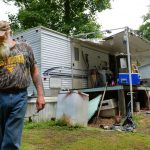Brett Hodgen with Kanawha Valley Home Inspections finds black colored mold inside of an Elkview home two years after the 1000 year flood ravaged portions of West Virginia. (WCHS/WVAH)
By: Sean Delancey | Posted: May 23, 2018 | Source: WCHSTV
ELKVIEW, W.Va. (WCHS/WVAH) — For many affected by the historic thousand year flood in West Virginia, it’s been hard to believe that the two year anniversary is just around the corner.
Lives were lost and homes destroyed. Everything people owned was thrown into heaps and carted off and that was just the beginning with weeks, months, and years of cleanup following the initial tragedy.
Dean Banks was one of thousands of victims when water covered his yard, flooded his basement, and then stayed there for days.
“We probably lost $65,000 to $70,000 dollars worth of stuff,” Banks said standing in his now remodeled basement.
For the next several weeks, Banks said volunteers stripped out the ceiling and drywall, took out all of the furniture and appliances, and then cleaned, bleached, and sprayed chemicals on every surface to kill mold or prevent it from developing.
“Every inch of this place was treated more than once,” Banks said laughing at the memory.
The question, two years later, could mold have survived and be thriving once again in the nooks and crannies of Bank’s home?
To answer that, Eyewitness News called in the professionals.
Brett Hodgen runs Kanawha Valley Home Inspections, and he came to Banks’ home to find out what mold could be inside and where.
“What I’m going to do first is set up an air pump,” Hodgen said while opening a black case on the back porch and pulling out a portable mold sensor.
He first took a sample of the air outside as a baseline to compare against the air inside.
Then he walked the perimeter of the home to see where water could possibly get inside.
Hodgen said the biggest exposure risks are clogged gutters or grading issues directing water toward the home’s foundation.
Once the baseline air test was completed, it was time to head inside and do it all over again.
As the little air filter collected mold samples inside the home, Hodgen’s dirty work began searching for a sample big enough to swab.
It didn’t take long.
Hodgen found a sizable mold growth hiding right where he expected to find it in the little hidden corners where air flow is low.
“It’s kind of running along this corner,” Hodgen said while searching the back room of the basement, “right through here is a little bit of black in color mold.”
Black is not the color of mold a homeowner would like to see because it could be Stachybotrys, a mold strain that can suppress a person’s immune system, cause mental health issues, or damage organs.
“It’s one I would like to identify,” Hodgen said.
Then it was time to swab it, seal it, and find out what it is.
“Send it off to the lab, and they’ll tell us what we’ve got,” Hodgen said.
The test results came back in a few work days with good news.
The air inside Banks’ home had fewer mold spored than outside showing the mold growth isn’t serious, and the swab was not Stachybotrys.
Instead, it was a more docile strain called Chaetomium only known to cause Hay Fever or asthma issues.
Hodgen said it’s still a good idea for Banks to remove the mold before it became in issue, and that’s where Bob Ritenour with Rainbow International Restoration came in.
“If you’re doing it yourself, it’s a difficult process,” Rttenour said.
He said mold removal is not as easy as wiping and bleaching visible mold.
Doing that could actually make the problem worse.
“Mold has a natural defense mechanism,” Ritenour said, “once something comes to try and kill it, it tries to take off.”
That’s why he would put plastic around the room to contain escaping spores, set up a HEPA air scrubber to pull them out of the air, use a HEPA vacuum to remove the main growth, and wear protective respirators and suits to keep the spores out of his lungs and off of his clothes.
“If you go home and pick up your grandchild, they’re going to breathe it right out of your shirt,” Ritenour said.
To keep it clean and mold free he would use a mixture of dish soap and an antimicrobial then hit it again with a pure antimicrobial to stop regrowth.
He said a bleach mixture is not always sufficient.
“In some instances the mold an go back on the bleach residue,” he said.
Keeping mold away long term is a matter of regular maintenance.
Ritenour said there are three factors to keep an eye on.
Mold would need a food source, water source, and a relative humidity above 40 percent to begin growing.
“If it doesn’t have any one of the three it won’t grow,” he said.
Keeping everything dry and using dehumidifiers has been effective in stopping mold growth in most cases.
That way, unless West Virginia gets hit with another 1,000 year flood, most homes should be relatively mold free.








